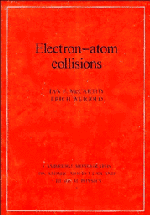Book contents
- Frontmatter
- Contents
- Preface
- 1 Introduction
- 2 Experimental techniques for cross-section measurements
- 3 Background quantum mechanics in the atomic context
- 4 One-electron problems
- 5 Theory of atomic bound states
- 6 Formal scattering theory
- 7 Calculation of scattering amplitudes
- 8 Spin-independent scattering observables
- 9 Spin-dependent scattering observables
- 10 Ionisation
- 11 Electron momentum spectroscopy
- References
- Index
11 - Electron momentum spectroscopy
Published online by Cambridge University Press: 15 December 2009
- Frontmatter
- Contents
- Preface
- 1 Introduction
- 2 Experimental techniques for cross-section measurements
- 3 Background quantum mechanics in the atomic context
- 4 One-electron problems
- 5 Theory of atomic bound states
- 6 Formal scattering theory
- 7 Calculation of scattering amplitudes
- 8 Spin-independent scattering observables
- 9 Spin-dependent scattering observables
- 10 Ionisation
- 11 Electron momentum spectroscopy
- References
- Index
Summary
Some atomic bound states have simple structure in the sense that a straightforward calculation obtains correct energy levels. In some cases optical oscillator strengths probe further detail. Collision theory has reached the stage where experimental observables for electron collisions involving such states can be calculated within experimental error. Observables whose calculation is sensitive to structure details constitute a probe for structure which verifies the details in more-difficult cases.
Scattering experiments are usually not very sensitive to structure. On the other hand the differential cross section for ionisation in a kinematic region where the plane-wave impulse approximation is valid gives a direct representation (10.31) of the structure of simple targets in the form of the momentum-space orbital of a target electron.
Electron momentum spectroscopy (McCarthy and Weigold, 1991) is based on ionisation experiments at incident energies of the order of 1000 eV, where the plane-wave impulse approximation is roughly valid. The differential cross section is measured for each ion state over a range of ion recoil momentum p from about 0 to 2.5 a.u. Noncoplanar-symmetric kinematics is the usual mode. In such experiments the distorted-wave impulse approximation turns out to be a sufficiently-refined theory. Checks of this based on a generally-valid sum rule will be described.
The reaction depends as much on the observed state |f〉 of the residual ion as on the ground state |0〉 of the target. Not only the single-particle structure but electron correlations in each state are sensitively probed in different circumstances.
- Type
- Chapter
- Information
- Electron-Atom Collisions , pp. 289 - 309Publisher: Cambridge University PressPrint publication year: 1995
- 1
- Cited by

